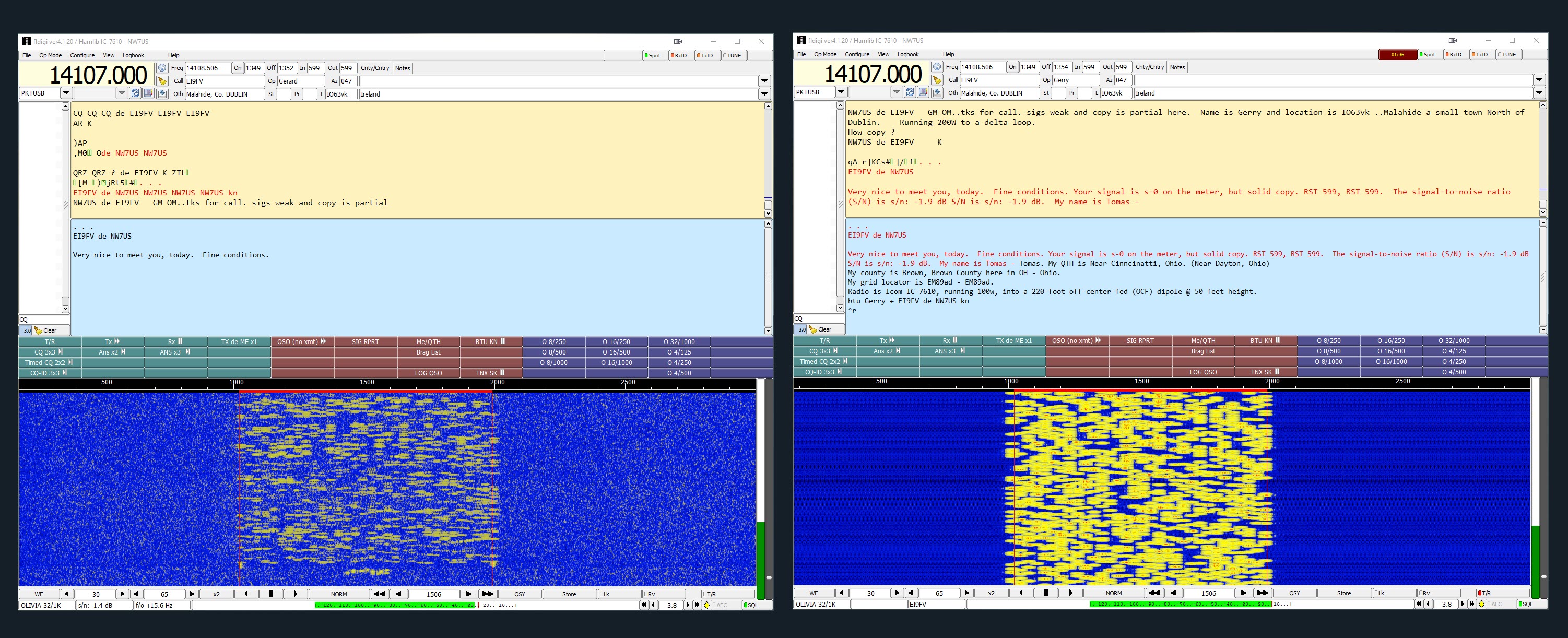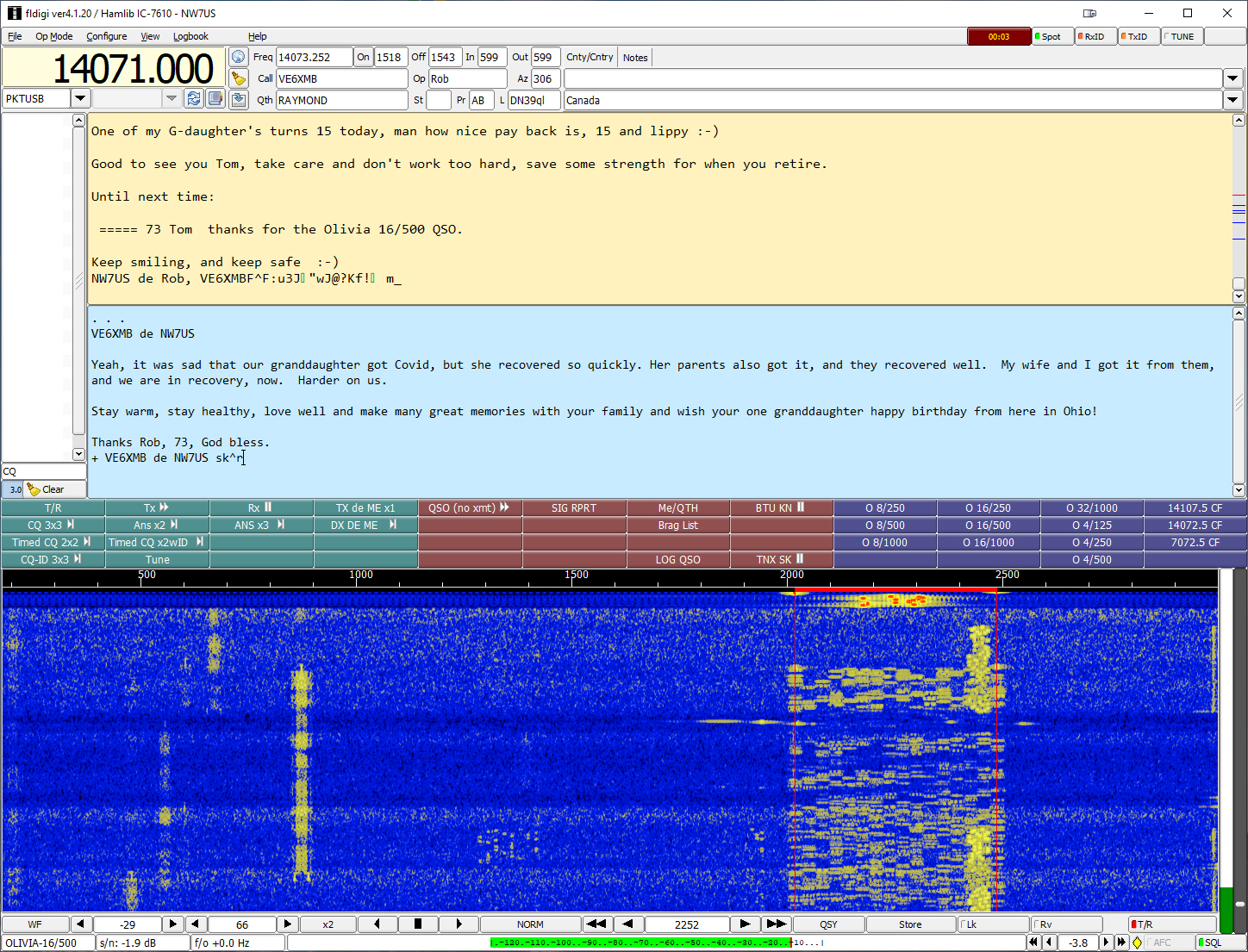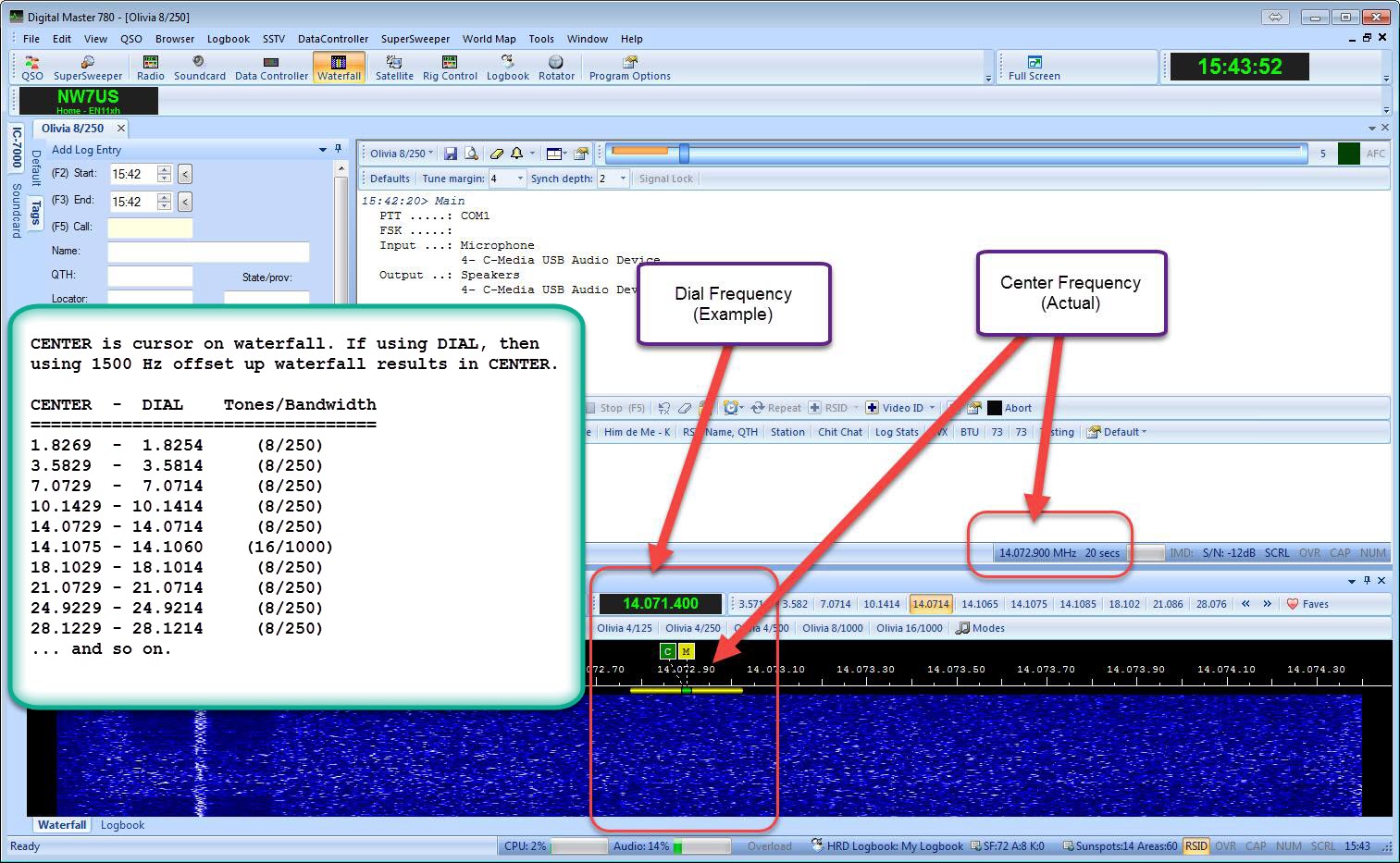Olivia Digital Mode on HF
The Olivia Digital DXers Club
~ and ~
the Olivia digital mode community welcome you!
Olivia on Groups.io →
Click to learn more about Olivia. Join our active community, read posts and files collection.
Olivia on Facebook →
Click to join our active Facebook community if you are a Facebook user.
Olivia on Discord →
Click for live Olivia spotting, announcements, and more...
Olivia DX Club: ClubLog →
Click to compare your DXCC status with other ODDC members...
NEW: 2023 December Olivia QSO Party →
Click to learn more about the 2023 Winter Olivia Digital Mode QSO Party.
Support the Olivia DX Club →
Click to help support our website and email server, etc.
Introduction Video (Presented to Raleigh Amateur Radio Society)
Please view our introduction to the Olivia digital mode for amateur radio HF usage for chat and emcomm.
About Olivia MFSK Digital Mode
Olivia, a Multi-Frequency Shift Keying (MFSK) radioteletype digital mode, is an amateur radioteletype protocol designed to work in difficult (low signal-to-noise ratio plus multipath) propagation conditions on shortwave radio (i.e., high-frequency, or HF) bands. The typical Olivia signal is decoded when the amplitude of the noise is over ten times that of the digital signal! It is commonly used by amateur radio operators to reliably transmit ASCII characters over noisy channels (slices of high-frequency spectrum -- i.e., frequencies from 3 MHz to 30 MHz; HF) exhibiting significant fading and propagation phasing.
The Olivia digital modes are commonly referred to by the number of tones and the bandwidth used (in Hz). Therefore, it is common to express the Olivia digital mode as Olivia X/Y (or, alternatively, Olivia Y/X ), where X refers to the number of different audio tones transmitted, and Y refers to the bandwidth in Hertz over which these signals are spread. Examples of common Olivia modes are, 8/250 (meaning, 8 tones/250-Hertz bandwidth), 16/500, and, 32/1000.
Here is a quick table of SUGGESTED calling frequencies.
History
The protocol was developed at the end of 2003 by Pawel Jalocha. The first on-the-air tests were performed by two radio amateurs, Fred OH/DK4ZC and Les VK2DSG, on the Europe-Australia propagation path in the 20-meter shortwave radio amateur band. The tests proved that the Olivia protocol (or, digital mode) works well and can allow regular intercontinental radio contacts with as little as one-watt RF power (when propagation is highly-favorable). Since 2005, Olivia has become a standard for digital data transfer under white noise, fading and multipath, flutter (polar path) and auroral conditions.
Some Technical Notes
Olivia, and the Misunderstood ALC
We get this question, often: "What should I set my ALC to when sending Olivia ? Does it work like FT8 with regards to splattering the band if there is (too much) ALC meter movement?"
Automatic Level Control (ALC) is a control circuit that governs the input signal to an amplifier. There are different amplifier circuits, some linear, some not.
Certain types of modulation have non-linear characteristics, while some have highly-linear characteristics.
Olivia is in the family of MFSK modulation schemes. Like any other form of angle modulation that transmits a single RF tone that varies only in phase or frequency, MFSK produces a constant envelope. This significantly relaxes the design of the RF power amplifier, allowing it to achieve greater conversion efficiencies than linear amplifiers. Of course, that means that Olivia is less prone to making an amplifier go out of linearity.
Linear amplifiers need to operate with class-A or class-AB biasing, which makes them relatively inefficient. While class-C biasing has far higher efficiency, a class-C amplifier is not linear, and is only suitable for the amplification of constant envelope signals. Such signals include FM, FSK, MFSK, Olivia, and CW Morse code.
Thus, as long as the ALC is not driven past its high limit, adjusting the sound input to the transceiver can be set higher than no ALC movement on the typical HF transceiver. Most operators that understand this will set the audio input to the transceiver up to the ALC level where adding any more volume no longer changes the ALC peak. Then, they back off a very tiny amount. Yes, setting the sound too high can still cause distortion, but if the ALC indicates that the input sound signal of the MFSK modulation is within its scale, then the signal should result in a clean amplification. Don't spread misinformation just because you heard or read that all digital signals should have NO ALC METER MOVEMENT or you are splattering. That's just untrue, especially with MFSK modulation, such as with Olivia.
References supporting this ALC information:

Ability to Handle QRM
It is well known that certain configurations of tones and bandwidth gives Olivia an edge when dealing with phase noise and other artifacts intrinsic to ionospheric propagation, especially over the polar regions. But, did you know that Olivia can handle a significant amount of QRM, and still have an effective communication (decode of the sent data)?

Current Community
Our community is strong, and growing in number. We have participants in many countries. To foster the community's growth and education, we must connect with each other.
- Please join our Olivia-mode email group (via Groups.io)
- Please join our Facebook Olivia group
The Facebook group is dedicated to instant communication for spotting, scheduling, and so on. Please join both of these groups.
Please share this everywhere possible, as part of our effort to rekindle the love for our conversational mode, Olivia.
Voluntary Channelization
Since Olivia signals can be decoded even when received signals are extremely weak, (i.e., signal to noise ratio of -14db), signals that are strong enough to be decoded are sometimes below the noise floor--below our ability to hear them, and not visible on the waterfall display--and therefore impossible to search for manually (by listening for the tones, or looking on the waterfall).
Therefore, in order to find other Olivia digital-mode signals, amateur radio operators have voluntarily decided to use channelization for this mode--at least for initial contact. This channelization allows even imperceptibly weak signals to be tuned properly for successful reception and decoding. Once contact is made, the operators are encouraged to move off of the calling frequency so that the channel may be used for other amateurs also trying to make that initial connection with other weak-signal stations.
By common convention, amateur stations initiate contacts on Olivia by utilizing the 8-tone, 250-Hz bandwidth configuration and then switch to other configurations (often, 8/500 when conditions are favorable) to continue the conversation. Below, you will find the lists of the common center frequencies of the weak-signal calling frequencies used in the amateur HF radio bands.
Current Olivia Calling Frequencies on HF
As stated, above, it is often best to get on standard calling frequencies with this mode because you can miss a lot of weak signals if you don't.
Note: some websites publish frequencies that are right on top of weak-signal JT65 and JT9 segments, and now, FT8/FT4 signals. DO NOT QRM (interfere with) weak-signal QSOs! You might not see or hear them, but those modes are often, if not always, occupying the neighboring frequencies right above our calling frequencies.
We (the active Olivia community members) suggest using Olivia 8/250 as the starting configuration when calling CQ on the USB frequencies that we've designated as our Calling Frequencies. As you've deduced by now, a calling frequency is a center frequency on which you initially call, “CQ, CQ ,CQ …” and then, once communications are established with an answering station, and with the agreement with the answering operator, you both move your operation to a new nearby clear frequency, perhaps changing the number of tones and changing the bandwidth, at your mutual agreement and discretion. Even though 8/250 is slow, the CQ call is short. But, it is narrow, to allow room for other QSOs nearby.
Current (2023) Suggested Starting Calling (and Listening) Frequencies
The frequencies listed below are suggested frequencies on which can be found WEAK (i.e., a signal that you cannot hear, a signal not seen on the waterfall) Olivia signals. While it is easy to spot a STRONG Olivia signal anywhere on the waterfall, by using these suggested calling frequencies at least once and a while, you will enable us to find your signal when the signal is too weak to hear and too faint to see on the waterfall. Olivia can do well with weak signals. Yes, our suggested 8 tone with 250 Hz bandwidth results in slow transmissions. But, it is one of the better settings when attempting to decode very weak signals. Once you make contact, you can move up or down a bit, away from the calling frequency, and then change to 16/500 or 8/500 to make the conversation go faster. But, on a calling frequency, it is advisable to configure operations in such a way as to increase the likelihood that you will find and decode that weak signal.
In the following list, CENTER is where you place the center of the software's cursor, and click to select that center frequency on the waterfall. If you use the DIAL frequency from this list, then click 1500 Hz offset up the waterfall (1500 Hz to the RIGHT of the LEFT side of the waterfall, if your waterfall is oriented horizontally with the lowest frequency on the left). This results in the software and transceiver being correctly tuned for the CENTER frequency.
The listing shows CENTER, then DIAL, then the number of tones and the bandwidth.
CENTER - DIAL (Tones/Bandwidth)
| CENTER | DIAL | TONES/BANDWIDTH | ||
|---|---|---|---|---|
| 1.8390 | 1.8375 | (8/250) ITU Region 1 | ||
| 1.8270 | 1.8255 | (8/250) ITU Region 2 | ||
| 3.5830 | 3.5815 | (8/250) | ||
| 7.0400 | 7.0385 | (8/250) ITU Region 2 | ||
| 7.0725 | 7.0710 | (8/250) Secondary | ||
| 10.1430 | 10.1415 | (8/250) | ||
| 10.1440 | 10.1425 | (32/1000) (Potential) | ||
| 14.0725 | 14.0710 | (8/250) | ||
| 14.1085 | 14.1070 | (32/1000) | ||
| 18.0990 | 18.0975 | (8/250) | ||
| 21.0725 | 21.0710 | (8/250) | ||
| 24.9225 | 24.9210 | (8/250) | ||
| 28.1225 | 28.1210 | (8/250) | ||
| and, so on... | ||||
REMEMBER THAT IF YOU USE THE DIAL FREQUENCY (THE SECOND FREQUENCY PER ROW),
SET YOUR WATERFALL CENTER AT 1500 Hz
Reference Listing:
Olivia Digital Mode Suggested Calling HF Frequencies
Example (screen grab showing an example):
ALSO: If your software is able to decode/encode the Reed-Solomon Identification signals (RSID), please turn on both received and transmit RSID.
An example is shown in the following video, which demonstrates enabling RSID in a popular software suite: https://www.youtube.com/watch?v=lBIacwD9nNM
Tips:
Do not switch to other modes without calling CQ for at least a five-minute window. It is horrid when people call CQ and change settings, modes, bandwidths, tones, every time they call CQ! Allow people time to get their software set to the right configuration, and ready to answer your CQ call.
PLEASE, TURN ON RSID (TXID and RXID in FLdigi)!
Make sure that your signal does not cross into other sub-bands where weak-signal modes are active. For instance, do not have any part of your signal at 14073.5 kHz or higher, as this is the sub-band for FT8, JT65A, JT9. DO NOT QRM (interfere with) WEAK-SIGNAL MODES such as WSPR, JT65A, and JT9! BE AWARE OF THE BAND PLANS OF THOSE MODES!
Operating OLIVIA
1. Please make sure you are using the RSID (Reed Solomon Identification - RSID or TXID, RXID) option in your software. RSID transmits a short burst at the start of your transmission which identifies the mode you are using.
When RSID does that, those amateur radio operators also using RSID while listening will be alerted by their software that you are transmitting in the specific mode (Olivia, hopefully), the settings (like 8/250), and where on the waterfall your transmission is located. This might be a popup window and/or text on the receive text panel. When the receiving operator clicks on that link or popup button, the software moves the waterfall cursor right on top of the signal identified by the RSID and changes the mode in the software. This will help you make more contacts!
NOTE: MixW doesn't have RSID features. Request it!
2. Olivia is NOT a weak-signal mode. While it is a mode that can decode weak signals, it is not a weak-signal mode like JT65 or FT8. The Olivia mode was designed not for weak-signal decoding as the primary design objective, but to overcome propagation-path phase issues and transpolar-region propagation challenges on HF.
There are no points won by barely making a contact. In USA FCC regulations, you use the power necessary to make the QSO. Typically, with poor propagation, 100w or more is the minimum to establish a reliable circuit. However, BEWARE! You cannot set your radio's output power above that which your radio's manufacturer has established as safe for full-duty cycle operation! You also must be sure that you do not overdrive the audio chain into your radio. Also, be sure that you do not have RF coming back into your audio chain. Let's say this, again: Yes, 100 watts is acceptable, and sometimes completely needed to make the QSO reliable. Don't let anyone convince you otherwise.
GET ON THE AIR AND STAY AROUND FOR A WHILE. KEEP TRYING! THE RESULTING RAGCHEW COULD BE VERY WELL WORTH THE WAIT!